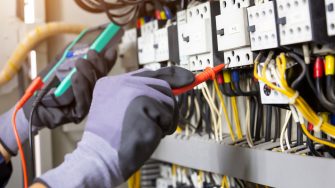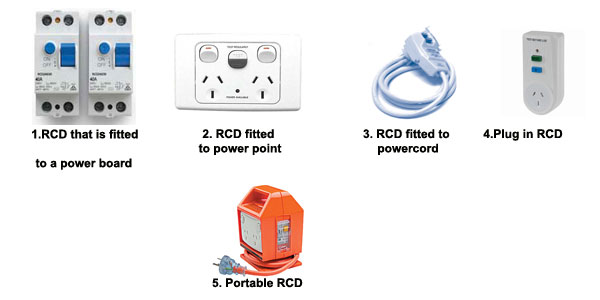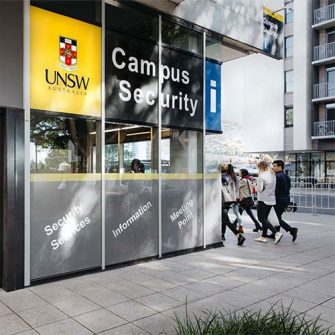
At UNSW we have a system of testing and tagging electrical equipment based on the Australian standard AS3760. The frequency of testing and tagging depends on where the equipment is located, how it is used and environmental factors. Refer to the Electrical Testing and Tagging Guideline, opens in a new window.
All electrical equipment must be tested and tagged.
Due-by date for the return of registers: 16th October, 2020
-
Electrical accidents can be life threatening, so it is very important that all staff and students take care when using either power points or electrical equipment. Specifically, everyone either using or inspecting power points or electrical equipment should:
- Report any damaged power cords or power points immediately and do not use equipment with damaged cords or damaged power points. Students should tell the nearest staff member about the electrical hazard.
- Staff members who notice an electrical hazard or to whom a student has reported the hazard, should report the hazard immediately.
- Place a handwritten notice in front of the damaged power point to warn others of the potential hazard and that it is being reported and date of your notice.
- If you are doing any work that involves portable electrical equipment or power cords, please be aware of trip hazards. Make sure power cords do not run across pathways or ensure that they are run in cable ramps.
- Always use residual current device's (RCD's) with portable electrical equipment, including extension cables. These devices (type 1 (10mA) and type 2 (30mA are available - see AS 3760) will reduce the risk of electrocution if the equipment develops an electrical fault (electricity leaking to Earth).
-
Electrical testing and tagging of appliances must be carried out by either an electrical contractor or a competent person. When organising a contractor for electrical work in your area, for example working on lights and power or testing and tagging, you must do the following:
- Ensure they are a licensed electrician with a current and valid licence. You can check if your electrician is properly licensed by:
- Asking to see their electrical contractor licence.
- Doing a licence check on the fair trading website, opens in a new window.
- Calling Fair Trading on 13 32 20.
- During workplace inspections check that all electrical items have been tested and tagged, and that they are in date.
- Ensure they are a licensed electrician with a current and valid licence. You can check if your electrician is properly licensed by:
-
The majority of electrical related fatalities could have been prevented by the use of a properly installed and maintained RCDs (Residual Current Device). RCDs, commonly referred to as "safety switches", are electrical safety devices designed to immediately switch off the supply of electricity when electricity leaking to earth is detected at harmful levels. RCDs offer high levels of personal protection from electric shock.

Requirements for RCD's
From 1 January 2013, new requirements for residual current devices (RCDs) will apply to workplaces where "plug in" electrical equipment (electrical equipment supplied with electricity through a socket outlet) is used in the following operating environments:
- electrical equipment is exposed to operating conditions that are likely to result in damage to the equipment (or a reduction in its expected life span) including conditions that involve exposure to moisture, heat, vibration, mechanical damage, corrosive chemicals or dust
- electrical equipment is moved between different locations in circumstances where damage to the equipment or to a flexible electricity supply cord is reasonably likely
- electrical equipment is frequently moved during its normal use
- electrical equipment forms part of, or is used with, an amusement device.
If electricity is supplied through a socket outlet that does not exceed 20 amps, then the RCD must have a tripping current that does not exceed 30 milliamps.
You may need to seek technical advice from a competent person about the kinds of RCDs that are appropriate for your workplace.
Note:
- New installations and modifications to pre-existing installations: Non-portable (fixed) RCDs are required. Refer to AS/NZS 3000:2007 Clause 2.4 Fault protection - & 2.6 Additional protection by RCDs. Exemptions refer to 2.6.3.1 and 2.6.3.4
- RCDs trip rating of 10mA or 30mA: Only type I (10mA) or type II (30mA) RCDs are to be used and they must comply with: AS/NZS 3190:2011 Approval and test specification - Residual Current Devices (current operated earth-leakage devices).
- 2020 UNSW Biological and Facility Register
- AED
- Asbestos
- Biological
- Building
- Chemical
- Confined Space
- Contractor Safety
- Electrical
- Fieldwork
- Gene Technology
- Hazardous Manual Tasks and Ergonomics
- Laboratory Safety
- Lasers
- Nanomaterials
- Noise
- Personal Protective Equipment (PPE)
- Plant
- Radiation
- Travel
- Visitors
- Working After Hours
- Working at Height
- Working environment



